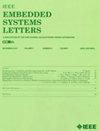FPonAP: Implementation of Floating Point Operations on Associative Processors
IF 1.7
4区 计算机科学
Q3 COMPUTER SCIENCE, HARDWARE & ARCHITECTURE
引用次数: 0
Abstract
The associative processor (AP) is a processing in-memory (PIM) platform that avoids data movement between the memory and the processor by running computations directly in the memory. It is a parallel architecture based on content addressable memory (CAM), allowing it to address data by its content and thus accelerating search and pattern recognition tasks. APs are suggested as a promising solution to the memory wall caused by the data movement bottleneck in traditional Von-Neumann architectures for data-driven applications, such as machine learning. However, modern implementations of the AP still lack support for floating point (FP) operations that are heavily used in the target applications. In this letter, we present a novel implementation of FP operations on the AP and evaluate its performance on the levels of latency and energy, showing that the proposed solution outperforms parallel FP execution on central processing unit and even GPU for large vector sizes.在关联处理器上实现浮点运算
关联处理器(AP)是一种内存中处理(PIM)平台,它通过直接在内存中运行计算来避免内存和处理器之间的数据移动。它是一种基于内容可寻址内存(CAM)的并行架构,允许它根据内容对数据进行寻址,从而加速搜索和模式识别任务。ap被认为是一种很有前途的解决方案,可以解决传统的冯-诺伊曼架构中数据移动瓶颈导致的内存墙,用于数据驱动的应用程序,如机器学习。然而,AP的现代实现仍然缺乏对目标应用程序中大量使用的浮点(FP)操作的支持。在这封信中,我们提出了AP上FP操作的新实现,并在延迟和能量水平上评估其性能,表明所提出的解决方案优于中央处理单元甚至GPU上的并行FP执行。
本文章由计算机程序翻译,如有差异,请以英文原文为准。
求助全文
约1分钟内获得全文
求助全文
来源期刊

IEEE Embedded Systems Letters
Engineering-Control and Systems Engineering
CiteScore
3.30
自引率
0.00%
发文量
65
期刊介绍:
The IEEE Embedded Systems Letters (ESL), provides a forum for rapid dissemination of latest technical advances in embedded systems and related areas in embedded software. The emphasis is on models, methods, and tools that ensure secure, correct, efficient and robust design of embedded systems and their applications.
 求助内容:
求助内容: 应助结果提醒方式:
应助结果提醒方式:


